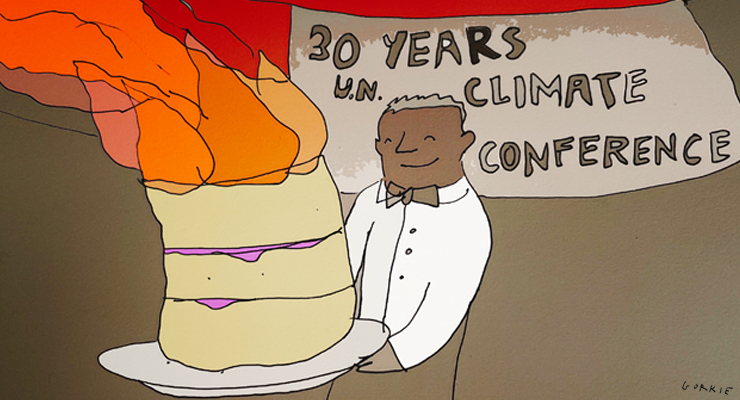
The most contentious issue in climate negotiations is money. It is accepted that rich countries need to help the developing world financially to reduce emissions and deal with climate change. How and how much has been a big topic in climate negotiations for decades. But developing economies do not see money flowing their way at anywhere near the scale needed.
The finance pledges from the 2015 Paris Agreement have still not been properly met. At COP26 last year, developed countries promised to double their climate adaptation finance to developing economies by 2025, in response to the fact that the gaps are largest for this type of climate finance, which developing economies need most. But developed economies have big public debts from the COVID-19 pandemic, and huge pressure at home to help people and businesses cope with energy bills. The German government alone is preparing to spend around €200 billion (A$310 billion) to buffer gas and electricity price rises. And interest rates are rising.
So funding pledges now look much harder to fulfil. This could become a particularly sore point as this year’s COP is hosted in Africa, a continent highly vulnerable to climate change and with generally poor financial resources. It’s likely there will be a strong focus on climate change adaptation and international equity.
In a basket yet harder is the so-called “loss and damage” debate. Developing countries argue that they should receive financial compensation for inevitable climate damages, given that it is mostly the rich that have caused climate change. The moral case is sound, but the politics in most rich countries is firmly stacked against sending money to poorer countries as compensation, as distinct from support for actions to reduce emissions or help deal with climate impacts. Loss and damage could become a bigger and bigger roadblock in climate negotiations.
Stepping back from controversies over money, the overarching topic for international climate policy is ambition. The Paris Agreement framework is geared to continually ratchet up the ambition in countries’ commitments to cut emissions. Last year’s COP decided that countries that had not yet updated their 2030 emissions targets should do so by now. But only a few have done so, and the overall strength of pledges remains insufficient.
The next important marker will be countries’ emissions targets for 2035, and COP27 is a waypoint to these. How climate ambition will fare over coming years as governments focus on national security and energy affordability is uncertain. Where geopolitical and energy pressure shifts policy and politics and especially where it has installed populist or right-wing governments, climate policy will tend to take a back seat. But it may also come back strongly on the agenda. This could come as a corollary of clean energy and industry policy, because of rising concerns about climate impacts, or as a way to strengthen international alliances between like-minded nations.
The short-term effect of Russia’s aggression is that European countries are compensating for lacking Russian gas by slowing the shift away from coal and nuclear power, by building infrastructure to import gas from elsewhere, accelerating renewable energy deployment and saving energy.
High energy prices in world markets encourage continued investment in new coal, oil and gas production, which runs counter to the climate objective. But they also promote investment in clean energy supply, investments to use energy more efficiently, and shifting from fossil fuels to electricity for example through heat pumps and electric cars. The sky-high prices of 2022 will not last.
Europe’s big Russia lesson is that dependence on energy imports can be dangerous. Diversification of import sources helps, but there is a fundamental sense that a safe energy supply needs domestic energy production. For any country not rich in fossil fuels this means renewable energy, or in some cases nuclear — climate-friendly options that also avoid the risk of future energy price shocks. In the words of Germany’s finance minister, “renewable energy is freedom energy”.
The new US Inflation Reduction Act gives huge subsidies for American clean energy industries. Europe supports its own emerging zero-carbon industries, as does China and other East Asian countries. The International Energy Agency, in its flagship annual report released last week, finds that global clean energy investment is poised to rise quickly.
For countries strong in clean energy technology, there can be a positive feedback effect on climate policy. If domestic industries benefit from the shift to zero carbon energy, then that is an extra reason for setting stronger emissions targets, and encouraging other countries to do the same.
And those greater investments in advanced green technologies tend to bring prices down, also making large-scale deployment more affordable in developing countries. This has been seen in the dramatic reductions in the cost of solar panels over the years, and it can be the case with other technologies from energy storage to electric cars.
The quest for industrial leadership in the shift to zero-emissions energy, industrial and transport systems holds real promise to drive global greenhouse gas emissions down.
In this light, the COP27 climate negotiations offer a chance for countries to affirm their commitment to cut emissions and strengthen their targets. That will hardly make up for the troubled state of affairs on climate finance. But it could be helpful in keeping the global climate talks on a positive track in difficult times.
Finally, the geopolitical shifts of this year may cause some countries to reposition on international climate action. New alliances could emerge, and ideas like the G7 “climate club” could blossom.
The crisis of 2022 sets global climate action back in the first instance, but the shakeup also holds opportunity.
Originally published under Creative Commons by 360info™.








Talk is delay. Do, is.
They still need to talk about the real impediment to slowing global warming which is state capture by fossil fuel interests. Especially in fossil fuel rich countries like Australia. If they dont address that then they are not serious.
Would it be too ‘out there’ that point out that even pretending that the C/C can be halted in any meaningful short term – eg a human life span – is a mug’s game?
The current atmospheric burden of CO2, CH4 (methane) and suspended particulates, the majority of which have been released this century, has already moved the world beyond the tipping point, viz permafrost thaw & sea temperature/current shifts being the most obvious.
The only sensible strategy is adaptation – to focus attention on a minor scale, consider the proposals to relocate Lismore (and any other town built on a floodplain, like western Sydney).
Ain’t gonna happen with our current political/social arrangement – until it must which will be wayyy too late.
Enjoy.